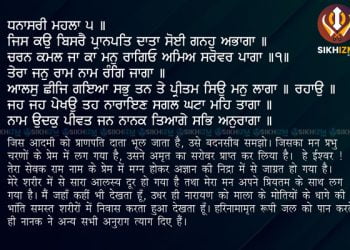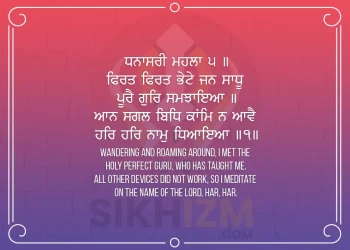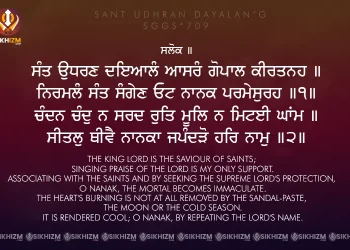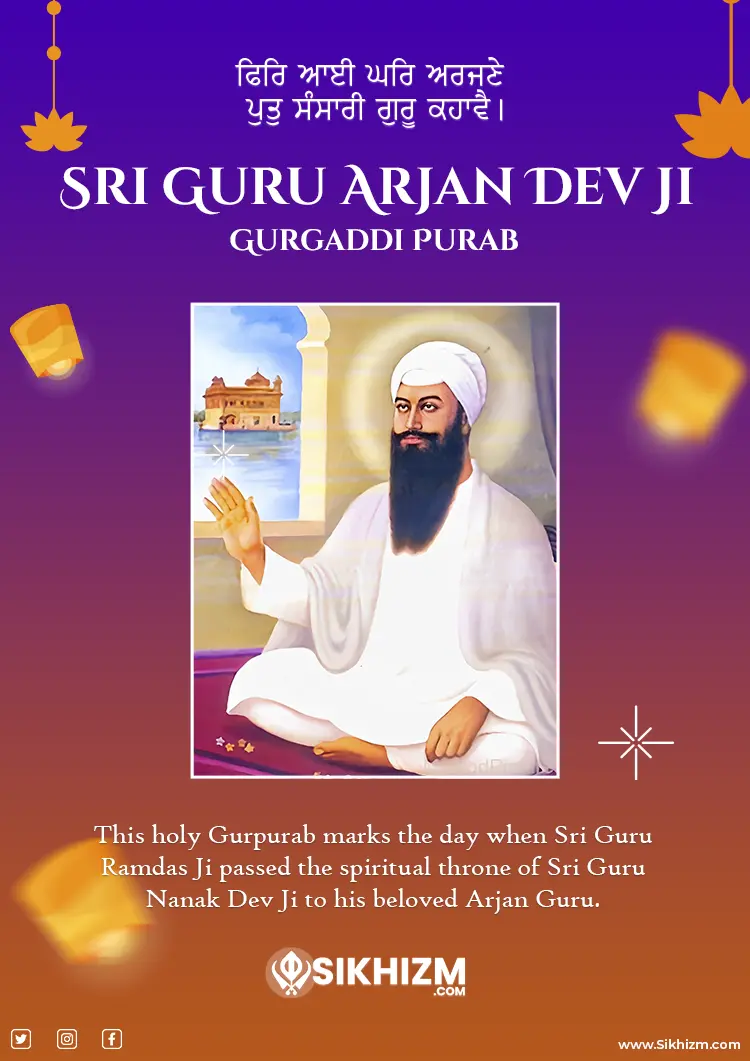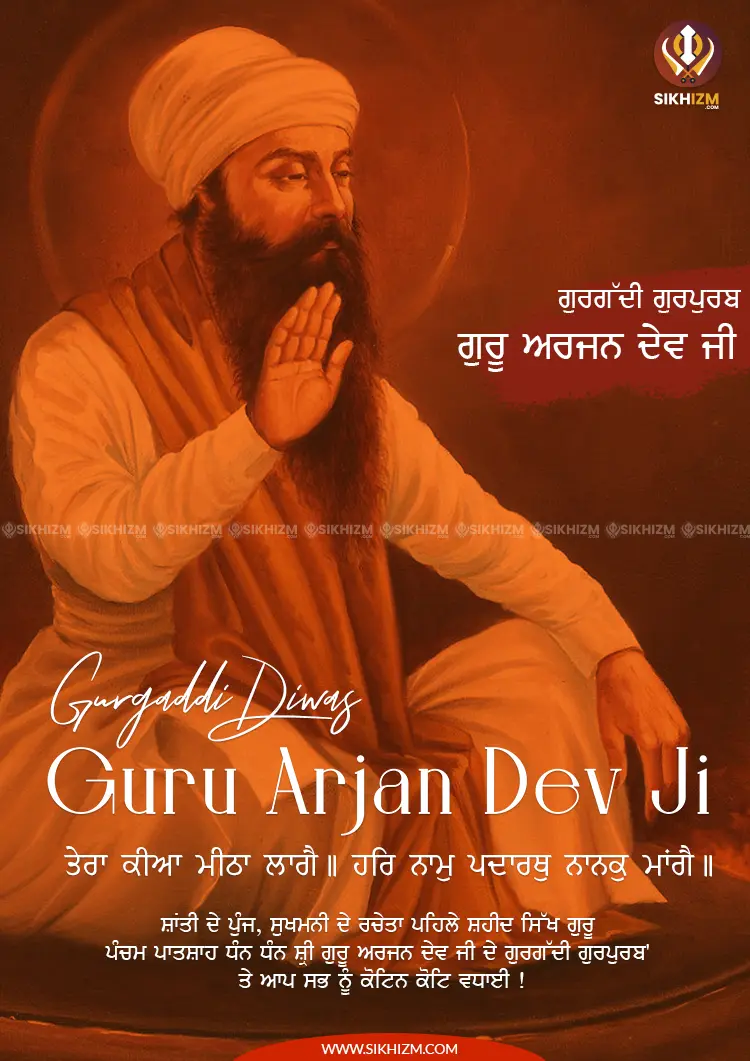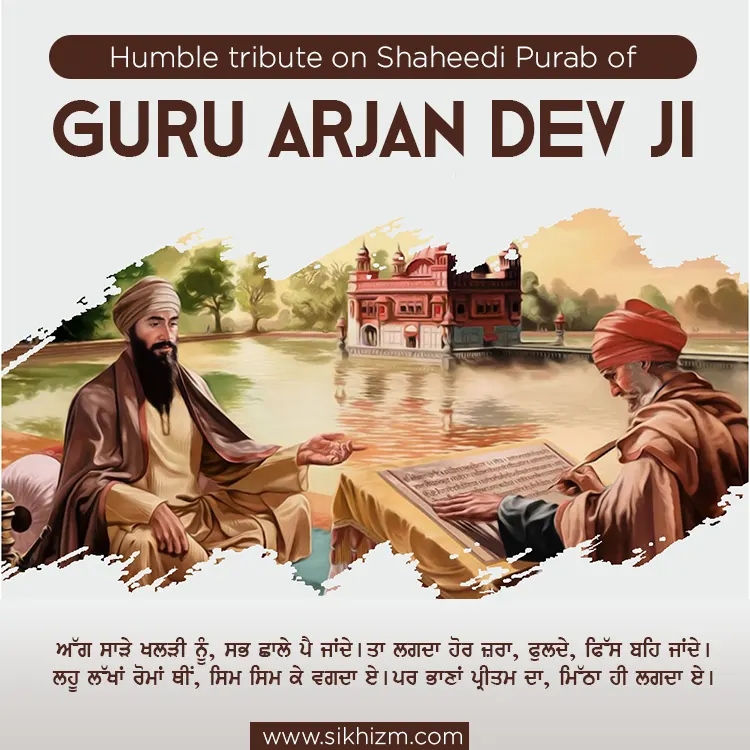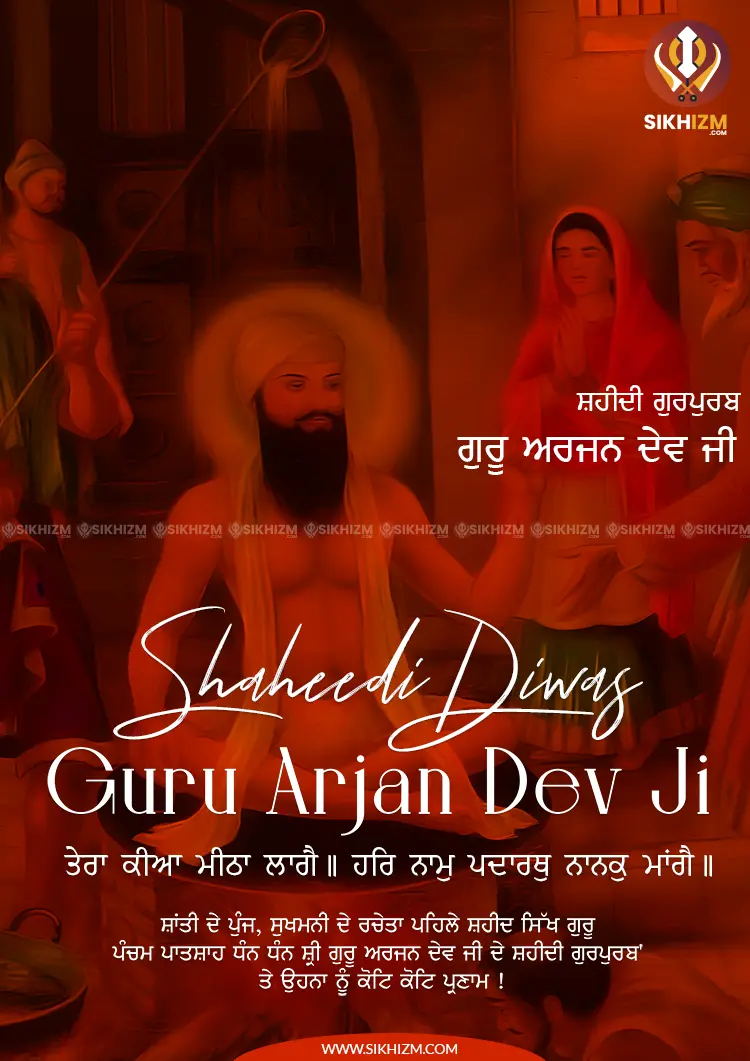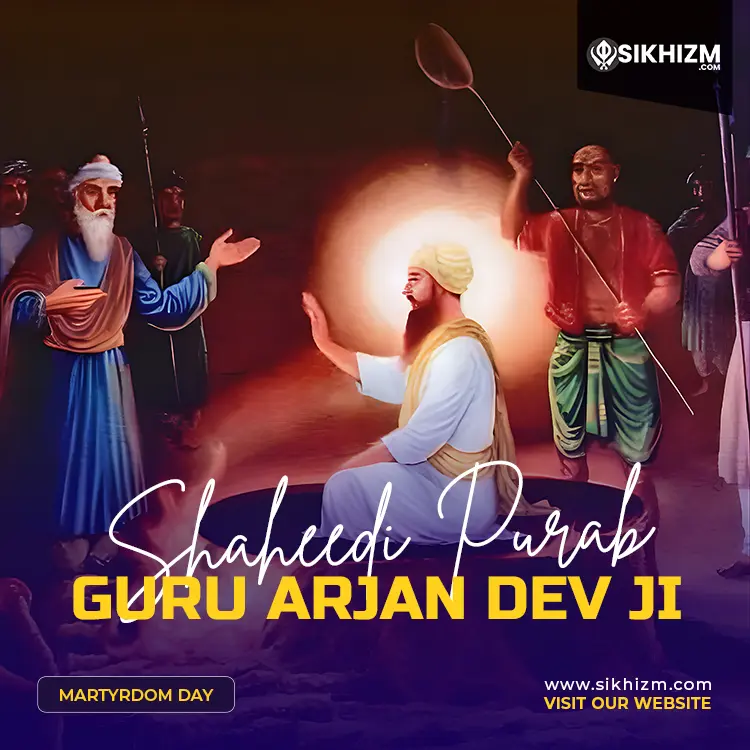Sri Guru Arjan Dev Ji
Sri Guru Arjan Dev Ji, the fifth Guru of the Sikhs, was born on 14 April 1563* at Goindwal, in the state of Punjab. He was the son of the fourth Guru, Guru Ram Das Ji and Bibi Bhani Ji. Sikh history has the distinction of having Bibi Bhani Ji as the daughter, wife and mother of a Guru, she is the daughter of the third Guru, Guru Amar Das Ji. Guru Arjan Dev Ji was born in Goindwal and brought up under the mentorship of Guru Amar Das Ji because Guru Ram Das Ji had established Goindwal Sahib as his permanent abode.
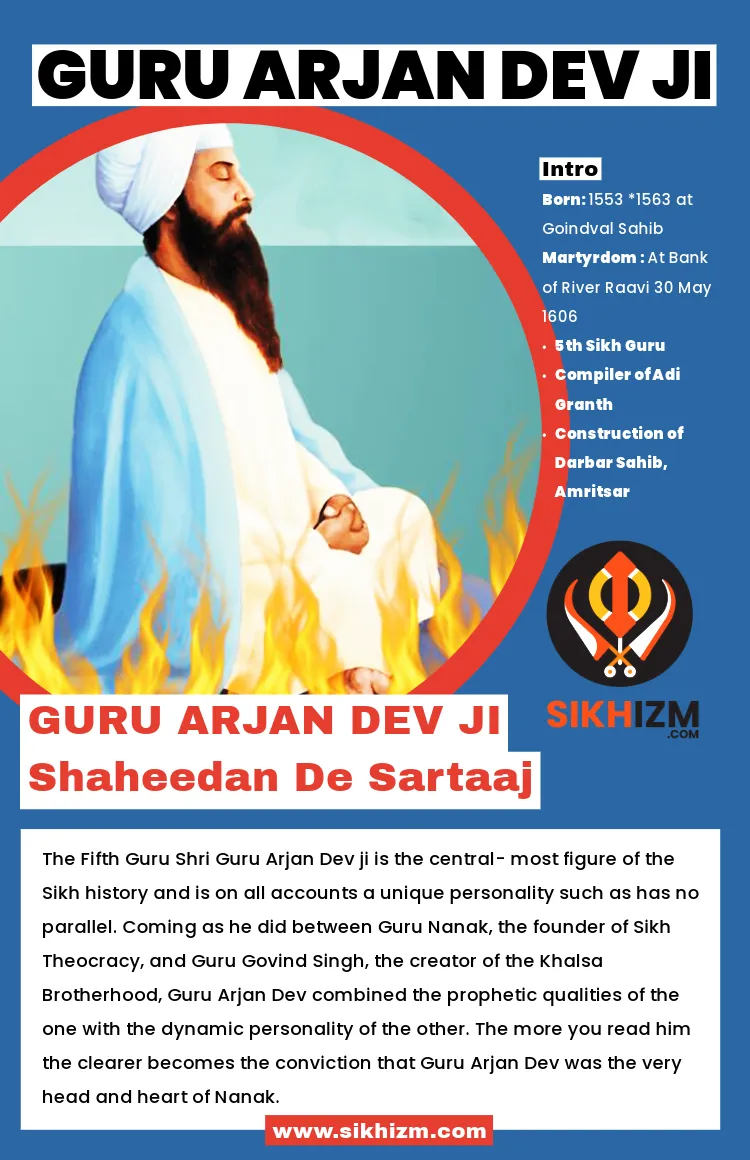
| Name of Guru | Sat Guru Arjan Dev Ji, Sodh Linage |
|---|---|
| Birthplace | Sri Goindwal Sahib |
| Birthday | *According to SGPC: 1620 Bikrami Vaisakh Vadi 7th (19th Vaisakh), Day Tuesday on April 14th, 1563 CE, Nakshatra Rohini. *13.4.1553 According to Sikh Historian Harjinder Singh Dilgeer. *Another source says Sunday, May 2, 1563, Goindval. |
| Parents | Mata Bhani Ji, Father Sri Guru Ram Das Ji, Grandfather (Maternal) Sri Guru Amar Das Ji |
| Spouse | Mata Ganga Ji, Daughter of Krishan Chand and Dhanvanti, From Mauu Village Near Phillaur, Married on 22 Assarh (Haarh) 1646 Bikrami. *19.06.1589 (HS Dilgeer) |
| Gurgaddi | 1638 Bikrami Bhadron Sudi 2nd, 18th September 1581 CE, 3 Days before the ascension of Guru Ram Das Ji. *30.8.1581 Guru Arjan Sahib was installed as the Fifth Guru according to Historian Harjinder Singh Dilgeer. |
| Joti Jot | Martyrdom on Jeth Sudi 4th (1st Harh) Samvat 1663, (May 30, 1606), Lahore, Gurudwara Dera Sahib on the bank of Raavi River, First Pehar of Morning. |
| Children | Sri Guru Hargobind Sahib Ji, Born 1652 Bikrami |
| Total Age | 42 Years 1 Month 27 Days |
| Guruship Period | 24 Years 9 Months 2 Days |
| Throned King | Akbar, Jahangir |
Guru Arjan Dev Ji Short Biography
The youngest son of Guru Ram Diis, a poet of great excellence, a philosopher in his own right, a builder and great organizer, and the first martyr in Sikh history was Guru Arjun. Even in his early years, he showed signs of great promise, faithfulness to the ideals, and a balanced mind toward his detractors, one of whom was his eldest brother, Prithi Chand, who did his worst to harm him to usurp the Throne, but who was paid back in nothing but forgiveness and charity. The other brother of Guru Arjun, Mahadev, was a recluse and was hence considered unfit to succeed his father.
Though Sikhs stood by Guru Arjun and sent in their offerings to him from far and near, these would hardly reach the Guru for they were intercepted on the way by Prithi Chand, even though the Guru had already assigned all income from the house property to his name and for himself and the community kitchen, he depended only on the offerings of the faithful.
To safeguard against it, the Guru appointed some of his trusted Sikhs in various places to collect the offerings from the faithful, who were required to set apart one-tenth of their incomes for communal purposes. These collections were to be offered to the Guru on the day of Baisiikhi each year by the Masands (or Agents of the Guru).
In the heart of the city of Amritsar, Guru Arjun built a temple, now· popularly known as the Golden Temple, open on four sides to signify that it was open to men of all four castes and men from all el four directions of the world. It is said, he asked a Muslim Sufi saint, Mian Mir, to lay its foundation stone. Later, the Guru built the cities of Tam Taaran and Kartiirpur, now in the districts of Amritsar and Jullundur respectively. Round the temples at all these pla~s, the Guru dug up huge tanks for people to bathe, in and keep themselves meticulously clean.
When in 1595, a son was born to Guru Arjun, Prithi Chand, who was hoping that the Guru being childless, the Throne would pass on to him or his son, started indulging in even viler intrigues. At first, he tried to poison the Guru's son, but failing in this he joined hands with a Muslim governor 'of Jullundur, Sulhi Khan, and incited him to attack him. But Sulhi died in most tragic circumstances much to the great chagrin of Prithi Chand.
Similarly, when one of Akbar's ministers, Bir Bal, imposed a tax on the Khatris of Lahore, and they led by the Guru, refused to pay it, Bir Bal threatened an armed attack. But it never matured, for Bir Bal was killed in another expedition. The Guru now settled down to a life of comparative peace and compiled the Adi Granth to make the Sikhs, men of the guidance that had been provided by Guru Nanak till Guru Ramdas. He had already given them a central place of worship, the Golden Temple, organized Sangats (congregations) under the Masands more effectively than before, and made it obligatory for Sikhs to part with them in favour of the Whole Community. This not only perfected the organization of the faith in every way but also gave Sikhs an idea, of peoplehood.
Meanwhile, Jahangir, the Moghal emperor of Delhi, was hearing reports of the growing influence of the Guru not only among the Hindus but also among the Muslims. Earlier, when a report was lodged with Akbar that the Guru had compiled a Book in which the Muslim faith had been reviled, he had asked the Book to be read out to him when he visited the Guru at Govindwal in 1598. When this was done, he was immensely pleased and satisfied that the Guru had a mission of synthesis rather than conflict and exclusiveness. But Jahangir was made of a different texture.

In these days, his son, Khusrau, rebelled against him, and in his flight towards Kabul, he called on the Guru, and, as is customary on such occasions the Guru blest him. But Jahangir reported that the Guru had offered him monetary assistance and even applied a saffron mark on his forehead to bless him in his fight against the Emperor. So, Jahangir believed in the report and also wanted to get rid of a person whose authority was growing, (as he admits in his autobiography, the Tuzak-i-Jahangiri, ordered that the Guru be arrested, his property confiscated by the State and he be made over to Murtaza Khan, his Kotwal in Lahore, to be tortured to death.
The Emperor's orders were carried out and the Guru died a martyr at Lahore on May 30, 1606.
Timeline from Life of Sri Guru Arjan Dev Ji

April 13th, 1553: Guru Arjan Sahib, the fifth Guru of the Sikhs, was born in Goindval, district of Gurdaspur, Punjab. He would later on be involved in the Sikhism religion, where he was to write the Adi Granth and establish the city of Taran-taran.
June 18th, 1579: Guru Arjan Sahib married Mata Ram Dei at Mau Sahib near Phillaur and became the fifth Guru of the Sikhs. This union was a vital part of his early life and created a long-lasting bond not only within the family but also in society.
August 30th, 1581: Guru Arjan Sahib was ordained the fifth Guru of the Sikhs when his father Guru Ram Das passed away. There were massive changes in religious and community affairs during his reign.
January 3rd, 1588: Guru Arjan Sahib initiated the construction of the Darbar Sahib, also referred to as the Harimandir Sahib, in Amritsar. This site would be transformed into the most sacred of all the places of worship in Sikhism.
January 26th, 1589: The construction of Santokhsar Sarovar, a large holy water tank was also executed during the period of Guru Arjan Sahib. This tank was featured in the overall plan to expand the Darbar Sahib complex.
June 19th, 1589: Guru Arjan Sahib married Mata Ganga as his wife. This marriage also brought more personal joy and also kept the line that would determine the future leadership of the Sikhs going.
April 13th, 1590: The construction of the Tarn Taran Sarovar was started by Guru Arjan Sahib. It would grow into a large holy tank and the town around it would become crucial religious and social hubs for the Sikh people.
November 24th, 1594: Kartarpur was established in Jalandhar by Guru Arjan Sahib. This town was intended to be home to the followers of Sikhism as well as a place where they could freely exercise their faith.
1597: Guru Arjan Sahib ordered a well to be dug at a place called Guru Di Vadali which is known as Chheharta. The well was christened with the name ‘Sakata’ which means six-spouted well and it enhanced the supply of water in the region.
Sri Guru Arjan Dev Ji: What He did for India and Mankind at Large?
Download "Sri Guru Arjan Dev Ji (1563-1606)" PDF with Subtitle "What He did for India and Mankind at Large?" by...
Read moreDetailsNovember 24th, 1598: Once, the Mughal Emperor Akbar along with his advisor Abu Fazl came to meet Guru Arjan Sahib at Goindwal Sahib. This visit also emphasized the fact that the Mughal Emperor had a cordial relationship with the Sikh Gurus.
1601: The construction of Darbar Sahib or the Golden Temple in Amritsar was over. This architectural masterpiece emerged as the focal point of Sikh worship for devotees around the globe.
July 31st, 1604: Guru Arjan Sahib finalized the process of compilation of the Sikh scriptures known as the Adi Granth Sahib (Pothi Sahib then). This was a great challenge because it entailed gathering and categorizing the hymns of the previous Gurus and other saints.
August 16th, 1604: Adi Granth was placed in the Darbar Sahib in a very religious manner with the Adi Granth Sahib being placed at the center. This installation was very important in the history of the Sikhs as it helped to make the scripture an important part of their worship.
April 6th, 1606: Prince Khusro Mirza, the son of Jahangir, was disobedient to his father and rebelled against him. Khusro went to seek the blessings of the Guru Arjan Dev Ji during his rebellion.
May 23rd, 1606: Emperor Jahangir was annoyed with Guru Arjan Sahib for supporting Khusro; therefore, he got the Guru arrested. This was followed by a series of disastrous incidents which led to the Guru’s sacrifice.
May 26th, 1606: Guru Arjan Sahib was arrested by Mughal forces and was tortured for three days but he never abandoned his faith.
May 30th, 1606: Guru Arjan Sahib was martyred after he had to undergo severe torture. His death is one of the most significant events in the history of the Sikh religion, as it motivated the community against any form of oppression.
Gurbani by Guru Arjan Dev Sahib Ji
ਜਿਸ ਕਉ ਬਿਸਰੈ ਪ੍ਰਾਨਪਤਿ ਦਾਤਾ
Jis Ko Bisre Praanpat Daata Soi Ganhu Abhaga. Charan Kamal Ja Ka Man Raageo Amea Sarovar Paaga.
Sukh Mangal Kalyan Sehaj Dhun
Sukh Mangal Kalyan Sehaj Dhun, Prabh Ke Charan Nihaareya is a sacred bani created by Fifth Guru Shri Arjan Dev...
Gur Kai Bachan Ridai Dhyan Dhari
Gur Kai Bachan Ridai Dhyan Dhari "Gur Kai Bachan, Ridai Dhyan Dhari; Rasna Jaap Japo Banwari";Raag Suhi Mahalla 5th, Guru...
Thaad Payi Kartare
Hukamnama Darbar Sahib Today: Thaadh Pie Kartaare, Taap Chhod Gaya Parwaare; Raag Sorath Mahalla 5 Bani Guru Arjan Dev Ji....
Gobind Simar Hoaa Kalyan
Gobind Simar Hoaa Kalyan, Miti Upaadh Bhaya Sukh Saacha, Antarjaami Simriya Jaan ; Raag Bilawal Page 826 of Sri Guru...
Firat Firat Bhete Jan Sadhu
Firat Firat Bhete Jan Sadhu, Poore Gur Samjhaya, Aan Sagal Bidh Kaam Na Aavei, Har Har Naam Dhiyaya; Bani Sri...
Tudh Bin Duja Nahi Koi
Tudh Bin Duja Nahi Koye, Tu Kartar Kare So Hoye; Mukhwak Sri Guru Arjan Dev Ji, documented on Ang 723...
Jiska Tan Man Dhan Sabh Tis Ka
Jiska Tan Man Dhan Sabh Tis Ka, Soi Sughad Sujani; Gurbani of Sri Guru Arjan Dev Ji from SGGS Ji...
Sant Udhran Dayalang | ਸੰਤ ਉਧਰਣ ਦਇਆਲੰ
Sant Udhran Dayalang Aasrang Gopal Keertanah (ਸੰਤ ਉਧਰਣ ਦਇਆਲੰ ਆਸਰੰ ਗੋਪਾਲ ਕੀਰਤਨਹ ) Baani Sri Guru Arjan Dev Ji, Guru...

















